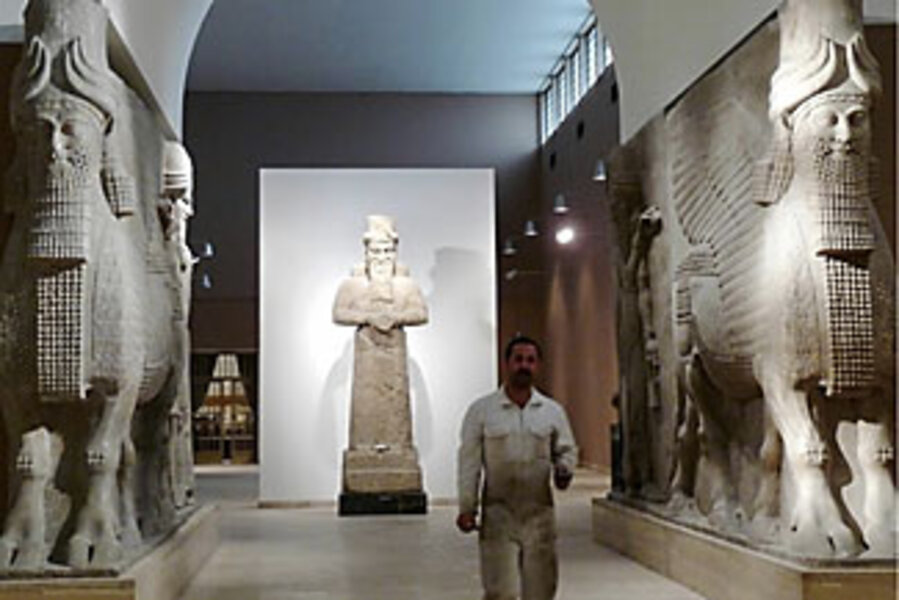A brief window opens into rarely seen Iraq Museum
Loading...
| Baghdad
Iraq Museum director Amira Edan, swamped by a pile of papers on her desk, sighs as she tries to explain the political firestorm swirling around the opening of the Iraq Museum, which became a symbol of the postinvasion looting that devastated Baghdad.
Over the past two weeks, the Ministry of Tourism had declared it would reopen soon. The Ministry of Culture had said it wouldn't. During the ministerial feud, experts proclaimed that it was still to dangerous and the museum itself wasn't prepared for the public.
In the end, there was a compromise: The museum will reopen Monday for the first time in six years. But only eight of the museum's 26 galleries will be accessible, and for only a few hours, to highlight stolen pieces that have been recovered – some from as far away as Peru.
Even though this has turned into a gala affair – a banner nearby heralds the "reinauguration" of the museum by Prime Minister Nouri al-Maliki – Ms. Edan, caught in the middle of the political dispute, is keen to give the event a much more modest description. "I think we can call it an exhibition," says the former head of the state board of antiquities.
Six years ago next month, in the immediate aftermath of the fall of Baghdad, looters swarmed Iraq's unprotected institutions. Outside the Iraq Museum – which tells the continuous story of 11,000 years of world civilization – US solders unprepared for the looting stood by in tanks without stopping it.
The resulting theft of more than 15,000 pieces from the museum sparked an international outcry and accusations of "cultural genocide."
Some of the 5,000 pieces that have either been voluntarily returned or seized will be highlighted in the exhibition attended by Mr. Maliki and senior Iraqi, US, and foreign officials but not the Iraqi public. Many of the pieces were returned with the help of the United States, which is eager to turn the page on this particular footnote of Mesopotamian history.
Notably absent will be the heart of the collection – including gold jewelry and ceremonial objects from the royal graves of Ur and Nimrud, which rival the treasures of King Tut's tomb.
"The collections of the Iraq Museum itself are in boxes in a safe place. We cannot show anything from that collection," says Edan. Officials will have to be content with looking at photos.
The last time the museum was opened with such fanfare was July 2003, when US administrator Paul Bremer peered into glass cases containing some of those priceless gold treasures. The museum was hastily closed just a few hours later in the midst of mortars and gunfire and hasn't reopened since.
"The opening of a museum is more than putting items in the showcases," says Edan. "It means lighting, it means having security control systems, alarms. But we received the order and we are doing our best…. We still do not know what we are going to do after the opening." She said, though, that she believed the controversy might make the Ministry of Tourism hesitate next time before ordering the opening of more galleries.
Opening or exhibition, museum staff have been working seven days a week to prepare for it.
On the weekend, when it is almost unheard-of for civil servants to be at work, the museum galleries were buzzing with workmen and archaeologists in overalls filling in for cleaning staff.
A maintenance man repainted the tan metal doors and gardeners watered the new flowers, which are planted near where bunkers protected the Iraqi gunmen who briefly fought US troops as they invaded Baghdad.
New Italian lighting cast a polished glow over the reliefs of Khorsabad lining the walls of the Assyrian gallery. But there are cracks in the ceiling and the museum still lacks security systems, fire alarms, and even an air-conditioning system. The US has pledged $14 million to help restore the museum but it will take much more, and Iraq's own funds are tied up in budget problems and bureaucracy.
What it lacks in funds, it makes up for in the passion of its staff, who treat the museum like a beloved family member.
"We've all studied together and worked together for years," says cuneiform expert Mahdi Rahim, who repaired and sold air conditioners to support himself as an archaeologist during the lean years of sanctions against Iraq in the 1990s.
On Saturday, Haji Abed Atiya al-Chameri, an elderly man in a long blue work coat and white head scarf, brought glasses of tea to Edan, the director. Earlier, he had been pushing a floor cleaner, showing up for work every day as he has for more than half a century – even though he retired last year and is no longer paid.
"He is the history of the museum – he just cannot imagine himself out of the museum," says Edan.
Mr. Atiya knew personally all the great archaeologists of the 1940s and 1950s, including Max Mallowan, who excavated Nineveh and married Agatha Christie. "Saddam was a madman," says the father of 11. "All those wars."
Atiya was at the museum when it was looted in 2003. "I felt very sad," he says. "I couldn't stop the terrorists – they were carrying machine guns."





